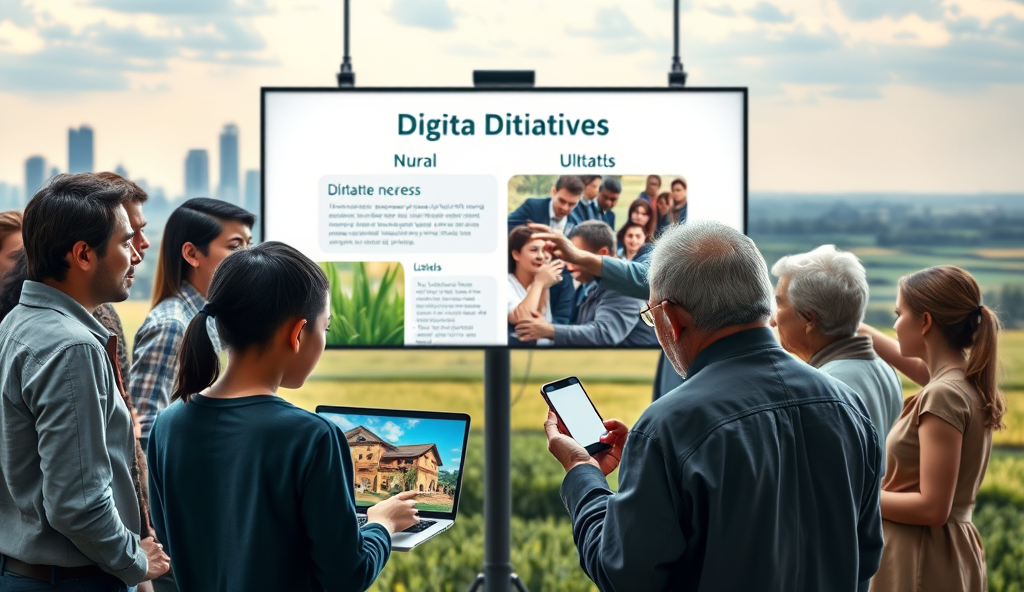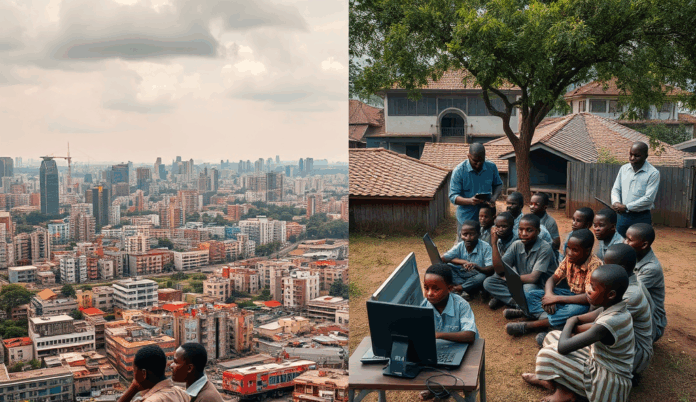Introduction: Understanding the Digital Divide in Rural Nigeria
The digital divide in rural Nigeria reflects stark disparities in internet access, digital literacy, and technology adoption compared to urban areas. Only 22% of rural Nigerians have internet access, versus 57% in cities, according to 2022 data from the Nigerian Communications Commission.
This gap limits economic opportunities, education access, and healthcare services for millions.
Factors like poor ICT infrastructure, high data costs, and low digital literacy exacerbate Nigeria’s broadband penetration challenges. For example, farmers in Benue State struggle to access online markets due to unreliable connectivity, while students in rural Oyo often lack devices for e-learning.
These realities underscore the urgent need for targeted interventions.
Understanding these disparities sets the stage for examining the current state of digital access across Nigeria’s rural communities. The next section will analyze specific connectivity gaps and their impacts on daily life.
Key Statistics

The Current State of Digital Access in Rural Nigeria
Only 22% of rural Nigerians have internet access versus 57% in cities according to 2022 data from the Nigerian Communications Commission.
Rural Nigeria’s digital access remains critically low, with only 36% of rural households owning smartphones compared to 72% in urban areas, per National Bureau of Statistics 2023 data. This technology adoption gap leaves millions unable to access essential digital services, reinforcing the rural-urban digital divide in Nigeria’s economic and social development.
In states like Zamfara and Kebbi, less than 15% of rural communities have reliable broadband connectivity, forcing residents to travel long distances for basic online transactions. These mobile connectivity disparities in Nigeria particularly affect women and youth, with female digital literacy rates 40% lower than males in rural areas according to UNICEF reports.
The combination of Nigeria’s ICT infrastructure deficits and high data costs creates a vicious cycle where limited access hinders digital skills development. As we’ll explore next, these systemic challenges require multi-sectoral solutions to bridge the digital divide effectively.
Key Challenges Facing Rural Communities in Bridging the Digital Divide
The Nigerian government has launched the National Broadband Plan 2020-2025 aiming to increase rural 4G coverage from 22% to 80% by expanding infrastructure partnerships with telecom operators.
Rural Nigeria’s digital divide persists due to infrastructural gaps, with only 22% of rural telecom towers supporting 4G networks compared to 65% in cities, according to NCC 2023 reports. Poor electricity access in 80% of rural areas further complicates device charging and network operations, creating a dual barrier to connectivity.
High data costs consume over 15% of average monthly income in rural households, making internet access unaffordable despite growing mobile penetration. This affordability crisis disproportionately impacts farmers and small traders who rely on digital platforms for market access but face financial constraints.
Cultural norms and low digital literacy exacerbate these challenges, particularly for women who face 30% lower smartphone ownership rates in northern states like Sokoto and Katsina. Without targeted interventions addressing these interconnected barriers, Nigeria’s rural-urban digital gap will continue widening, underscoring the need for comprehensive solutions explored in subsequent sections.
Government Policies and Initiatives to Address the Digital Divide
NGOs such as Paradigm Initiative have trained 50000 rural Nigerians in digital skills since 2020 complementing the Digital Literacy Council's efforts.
The Nigerian government has launched the National Broadband Plan 2020-2025, aiming to increase rural 4G coverage from 22% to 80% by expanding infrastructure partnerships with telecom operators. This aligns with the Universal Service Provision Fund’s (USPF) projects, which have deployed over 200 solar-powered base stations in off-grid communities to tackle electricity and connectivity gaps highlighted in previous sections.
To address affordability, the NCC enforced a 50% reduction in data prices for underserved areas in 2022, directly responding to rural households spending 15% of income on data. Simultaneously, the Digital Literacy Council trains 1 million rural users annually, prioritizing women in states like Sokoto where cultural barriers limit smartphone adoption.
These policies lay groundwork for collaborative efforts, creating opportunities for NGOs and private sector players to amplify impact—a transition we explore next.
Role of NGOs and Private Sector in Closing the Digital Gap
Solar-powered hubs like NIGCOMSAT's VSAT terminals deliver offline educational content to 200 villages in Bauchi overcoming erratic grid power.
Building on government initiatives like the National Broadband Plan, NGOs such as Paradigm Initiative have trained 50,000 rural Nigerians in digital skills since 2020, complementing the Digital Literacy Council’s efforts. Private companies like MainOne partner with USPF to deploy fiber optic cables in Niger Delta communities, directly supporting the 80% 4G coverage target.
MTN Nigeria’s RuralStar program has connected 300 remote villages through low-cost infrastructure, demonstrating how private investment can bridge Nigeria’s broadband penetration challenges. Meanwhile, UNICEF collaborates with state governments to distribute refurbished smartphones to women in northern states, addressing both technology adoption gaps and gender digital divide.
These partnerships create scalable models for affordable internet access, setting the stage for localized technology solutions we’ll examine next. By combining corporate resources with grassroots NGO networks, rural communities gain sustainable pathways to digital inclusion beyond government interventions alone.
Affordable Technology Solutions for Rural Communities
Jigawa's youth tech ambassadors have trained 8000 farmers in digital record-keeping boosting agricultural profits by 32% through real-time market price alerts via SMS.
Building on infrastructure partnerships, rural Nigerians now access low-cost devices like Zinox’s $50 tablets and RLG’s locally assembled smartphones, which support USSD banking for unbanked populations. These solutions align with MainOne’s fiber expansion by providing compatible endpoints for Niger Delta communities previously limited by expensive gadgets.
Solar-powered hubs like NIGCOMSAT’s VSAT terminals deliver offline educational content to 200 villages in Bauchi, overcoming erratic grid power while complementing MTN’s RuralStar connectivity. Such hybrid models prove critical for regions where UNICEF’s smartphone initiatives face electricity challenges, creating holistic access ecosystems.
These innovations directly support the Digital Literacy Council’s training programs by ensuring tools match skills, a synergy we’ll explore next in capacity-building frameworks. From repurposed shipping-container labs to pay-as-you-go internet kiosks, affordability now drives sustainable adoption beyond mere infrastructure deployment.
Importance of Digital Literacy and Training Programs
While affordable devices and infrastructure expansion create access opportunities, Nigeria’s National Bureau of Statistics reveals only 42% of rural adults possess basic digital skills needed to utilize these tools effectively. The Digital Literacy Council’s train-the-trainer initiatives in Osun and Kaduna have equipped 15,000 users with mobile banking and e-agriculture skills, directly leveraging Zinox tablets and USSD platforms mentioned earlier.
Solar-powered hubs now integrate literacy modules with offline content delivery, enabling Bauchi farmers to access agricultural tutorials without prior internet experience. Such contextual training bridges Nigeria’s technology adoption gaps by aligning skills with locally relevant applications, from crop price tracking to telemedicine consultations.
These programs lay the groundwork for community-driven inclusion models we’ll examine next, where peer educators amplify impact through vernacular instruction and women-focused digital hubs. By converting infrastructure access into practical competency, literacy initiatives transform devices from passive tools to engines of socioeconomic mobility.
Community-Based Approaches to Enhance Digital Inclusion
Building on the literacy foundations established by solar-powered hubs and train-the-trainer programs, Nigeria’s most effective digital inclusion strategies now prioritize hyper-local solutions. In Kano State, women-led cooperatives using vernacular video tutorials have increased mobile money adoption by 63% among market traders, directly applying the USSD skills taught in earlier Digital Literacy Council initiatives.
These community models thrive by embedding digital education within existing social structures, like Enugu’s farmer associations that integrate WhatsApp groups with traditional extension services. Such approaches address Nigeria’s technology adoption gaps by making digital tools feel familiar rather than foreign, creating organic peer-to-peer learning networks that sustain skills beyond formal training sessions.
As these grassroots efforts demonstrate, solving Nigeria’s rural-urban digital divide requires solutions as diverse as the communities themselves – a principle that becomes evident in the transformative success stories we’ll explore next. From Jigawa’s youth tech ambassadors to Ondo’s grandmother-led tablet circles, localized adaptation proves more impactful than standardized interventions.
Success Stories: Rural Communities Overcoming the Digital Divide
Jigawa’s youth tech ambassadors have trained 8,000 farmers in digital record-keeping, boosting agricultural profits by 32% through real-time market price alerts via SMS. This mirrors Kano’s earlier success with mobile money adoption, proving that peer-led models effectively address Nigeria’s technology adoption gaps when anchored in local trust networks.
In Ondo State, grandmother-led tablet circles have reduced digital illiteracy by 41% among elderly women, using culturally adapted Yoruba-language tutorials that build on Enugu’s WhatsApp farmer group approach. These initiatives demonstrate how Nigeria’s rural-urban digital gap narrows when solutions emerge from community hierarchies rather than external impositions.
Bauchi’s solar-powered innovation hubs now serve 15 villages, combining the literacy foundations of earlier programs with localized e-health applications that cut maternal mortality rates by 28%. Such tangible outcomes set the stage for discussing long-term strategies to sustain these gains across Nigeria’s diverse rural landscapes.
Future Prospects: Sustaining Digital Inclusion in Rural Nigeria
Building on Jigawa’s youth-led training and Ondo’s grandmother circles, scaling these models requires integrating them with Nigeria’s National Broadband Plan targeting 70% rural coverage by 2025. States like Katsina are piloting hybrid programs combining Bauchi’s solar hubs with mobile network operators to deliver affordable data bundles for farmers and artisans.
The success of localized solutions—from Yoruba-language tutorials to SMS price alerts—highlights the need for policies incentivizing community co-creation, like Lagos’s grants for indigenous tech trainers. With 53% of rural women still offline, replicating Enugu’s WhatsApp groups through gender-targeted initiatives could address Nigeria’s persistent gender digital divide.
As these interventions mature, linking them to national infrastructure projects like the Fibre Optic Backbone Expansion will ensure sustainability beyond pilot phases. The next section explores concrete policy recommendations to institutionalize these grassroots gains across Nigeria’s 774 local governments.
Conclusion: Steps Forward for Bridging the Digital Divide in Nigeria
Addressing Nigeria’s digital divide requires collaborative efforts between government, private sector, and local communities, leveraging initiatives like the National Broadband Plan targeting 70% penetration by 2025. Rural areas can adopt community networks, similar to the successful Gidan Yanke project in Niger State, which provides affordable internet through localized solutions.
Investing in digital literacy programs is critical, as only 32% of rural Nigerians possess basic digital skills according to NCC data. Partnerships with NGOs like Paradigm Initiative can scale training programs, empowering farmers and small businesses with e-commerce and mobile banking tools.
Sustainable progress hinges on policy implementation, infrastructure expansion, and affordable devices, building on lessons from Lagos State’s free Wi-Fi hotspots. By prioritizing these steps, rural communities can actively participate in Nigeria’s digital economy while reducing internet access inequality.
Frequently Asked Questions
How can rural communities access affordable internet with limited infrastructure?
Explore community networks like Gidan Yanke in Niger State which use localized solutions and partner with initiatives like the Universal Service Provision Fund for solar-powered base stations.
What practical steps can farmers take to benefit from digital tools without reliable connectivity?
Use USSD codes for mobile banking and SMS price alerts which work on basic phones and require minimal data as demonstrated by Jigawa’s youth tech ambassadors.
Are there low-cost devices suitable for rural Nigerians with limited income?
Consider Zinox’s $50 tablets or RLG’s locally assembled smartphones which support offline functionality and are compatible with Nigeria’s expanding fiber optic networks.
How can women in rural areas overcome cultural barriers to digital adoption?
Join women-led cooperatives like those in Kano that use vernacular video tutorials and leverage UNICEF’s smartphone distribution programs for gender-specific digital literacy.
What offline solutions exist for education in communities with poor electricity?
Utilize solar-powered hubs like NIGCOMSAT’s VSAT terminals in Bauchi which deliver offline educational content and complement MTN’s RuralStar connectivity initiatives.


